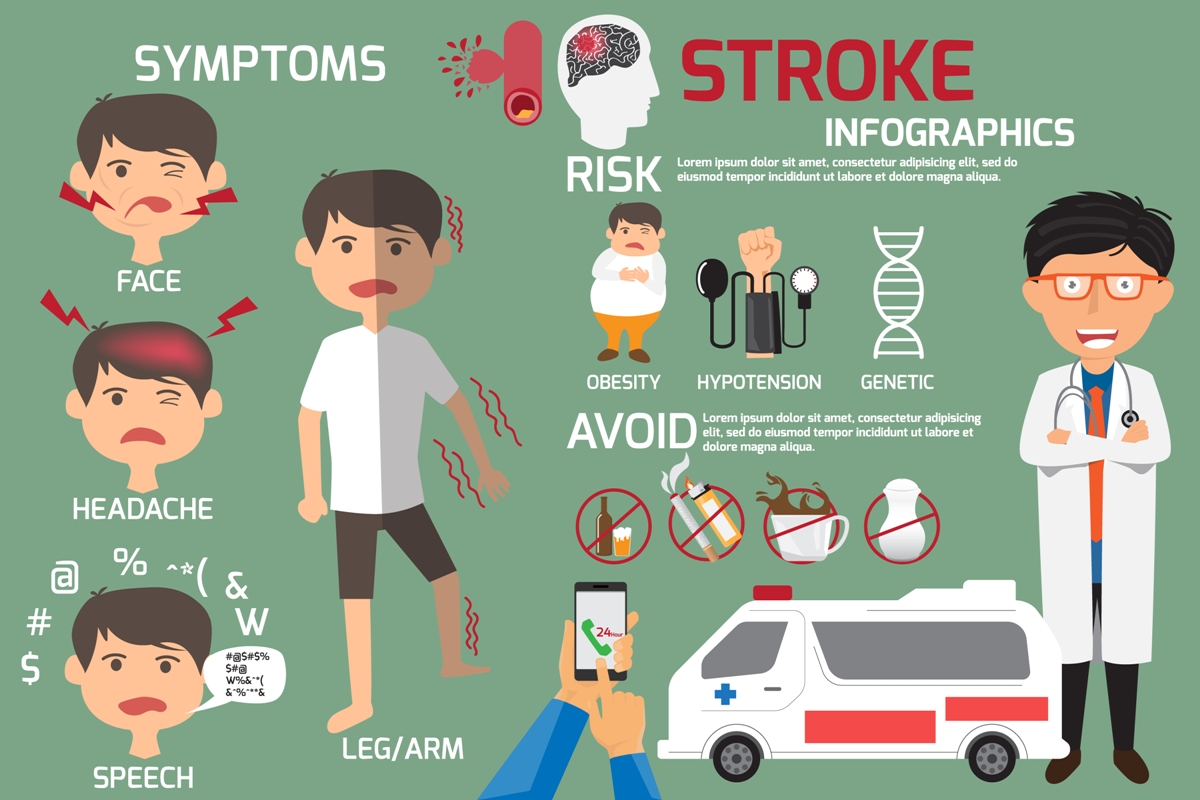A stroke (also called cardiovascular accident-CVA or brain attack) occurs when a part of the brain ceases to get adequate blood supply, resulting in cell deaths. That particular part of the brain, and the parts of the body it controls, stop working.
Types of stroke:
Depending on cause, strokes are broadly classified as:-
Ischemic stroke – part of the brain loses blood supply due to blockage in a blood vessel
Hemorrhagic stroke– bleeding occurs in the brain due to bursting of blood vessels
Transient Ischemic Attack (TIA)- also known as a mini stroke-which resolves usually in a few minutes, but may take up to 24 hours in some cases. It could be a sign of a full blown stroke in the future.
Risk Factors:-
- Hypertension
- Diabetes Mellitus
- High Cholesterol
- Smoking
- Increasing age
Alarmingly, the age at which people become susceptible to strokes has reduced; more than one third of strokes reported are in people aged 49 to 60.
Less common conditions like atrial fibrillation, illicit drug abuse and genetic predisposition could also play a role.
Symptoms:-
- Confusion, change in level of consciousness
- Weakness
- Paralysis
- Double vision or loss of vision
- Slurred speech
There may be no sign or symptom before the onset of a stroke, catching the person unawares.
How do you spot a stroke?
“FAST” is an acronym for the signs you should observe, if you think someone is having a stroke.
F- Facial Drooping– Is the face drooping to one side? Can the person smile?
A – Arm Weakness– Can the person lift his arm and keep it up? They might not be able to, because of weakness in the limb.
S – Is their speech slurred? Often, the person isn’t able to speak clearly, or speak at all…they may not be able to hear you either.
T – It is time to call emergency services if you observe any of the above symptoms in a person.
A stroke is a serious condition, and requires immediate medical attention. Once you suffer a stroke, the best treatment will be decided on by your physician. However, there are certain lifestyle changes you can follow, which will reduce your chances of having strokes. It is especially important for someone who has already suffered a stroke, as you are at a high risk of getting another.
These few lifestyle changes can help you…
Eat a healthy diet and maintain your weight
Obesity can put you at risk of suffering from ischemic stroke; it increases the chances by 67%. Therefore, maintaining a normal weight range is very important. If your BMI is 18.5 to 24.9, it falls within the normal or Healthy Weight range. If your BMI is 25.0 to 29.9, it falls within the overweight range. If your BMI is 30.0 or higher, it falls within the obese range.
Your weight depends, to a large extent, on your diet- they go hand in hand. A healthy, nutritious and balanced diet will not only help maintain weight, but also benefit you in terms of micronutrients. Include a lot of whole grains, fruits and veggies in your diet, try avoiding or limiting fatty and sugar loaded treats. A low fat, high fiber diet is recommended. Eat small meals at frequent intervals; it helps regulate your blood sugar over the day, preventing binge eating.
Make Exercise a regular routine
Research from the stroke association shows that regular exercise reduces your chances of stroke by 27 %. Experts advise at least 30 minutes of moderate exercise 5 days a week.
If joining the gym is not your cup of tea, you can take up an outdoor sport- squash, badminton, and swimming. Even a slow walk for 30 minutes a day is helpful.
Reduce your salt intake
Excessive salt intake can cause complications like cardiac failure, hypertension, osteoporosis and stroke. Officials suggest a salt intake of no more than 6 Gms per day. The problem lies in the hidden salt you consume, in breads, sauces etc. Adding extra salt to your meals could result in way too much salt consumption…you need to be careful.
Watch the alcohol
Alcohol can give rise to a lot of conditions predisposing you to stroke. It’s important to watch the quantity of alcohol you consume.
Experts say you shouldn’t, at any point in time, have more than 10 standard drinks a week, no more than 4 on any one day ( 1 standard unit is 10 ml or 8 gms of pure alcohol).
The journal STROKE conducted a study, showing that people averaging 2 standard units a day were at a 34% higher risk of developing strokes than those who averaged less than ½ a unit a day.
The less you consume, the better it is for you.
Quit smoking
Smoking is injurious to health- a saying we all are familiar with…we just don’t know how much!
Tobacco smoke releases toxins like carbon monoxide and nicotine in your body, reducing the oxygen in your blood, and nicotine causes hypertension and conditions like fibrillation and arrhythmias, increasing your chances of a stroke. It can narrow your arteries and affect blood clotting too.
Studies have found that a hypertensive who smokes is about 15 times more at risk of developing a stroke. So, if you do smoke, you need to think about quitting.
These lifestyle changes will help you prevent a stroke, but if you suffer from a condition that predisposes you to having a stroke, you need to manage the condition, take medications as prescribed and follow your physician’s advice.








